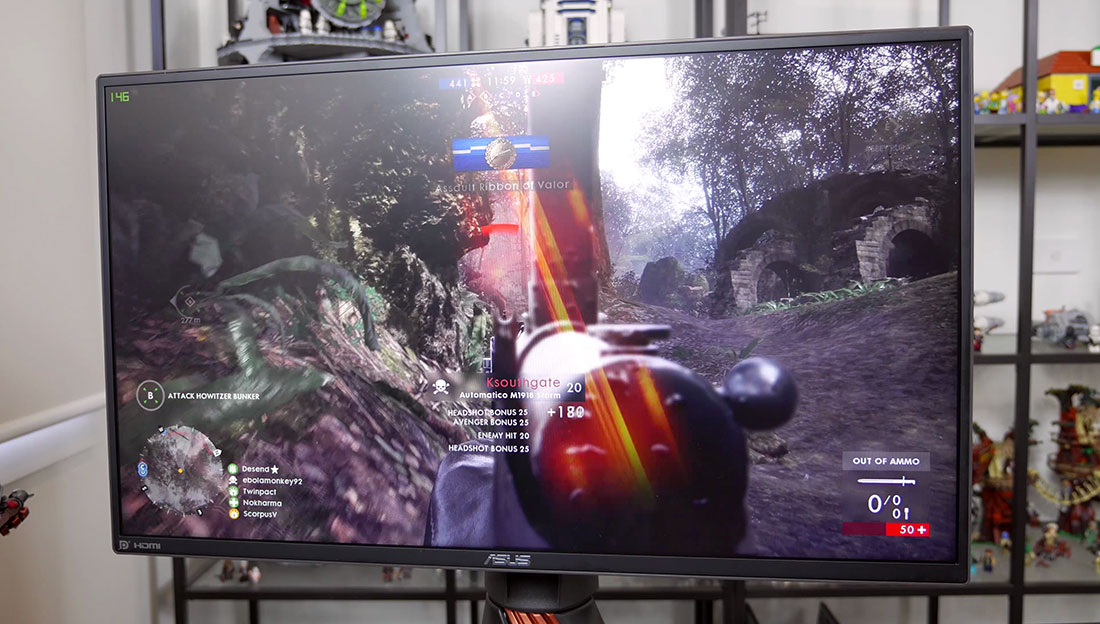The Asus ROG Swift PG258Q is a 24.5-inch 1920 x 1080 TN LCD monitor. Now you may be thinking this collection of specs isn't hugely impressive - and by itself it certainly isn't - but there's one key feature to this monitor that is very attractive for fans of high-paced esports titles. The PG258Q sports a whopping 240 Hz refresh rate, combined with G-Sync, for the ultimate low latency, high refresh experience.
Most basic 24-inch 1080p displays clock in around $150, and these days you can even get 144 Hz monitors in the $200 to $300 range. The PG258Q, however, is significantly more expensive: for those that want 240 Hz and Nvidia's variable refresh technology, you'll need to hand over a massive $599.99, which effectively restricts this display to all but enthusiast gamers.
So what do you get for your $600? Well, in true Asus ROG Swift fashion, the PG258Q features many gamer elements. The stand is a wide, three-pronged design with interesting copper vent highlights, while the rear of the monitor features aggressive shapes and a 'tech' pattern. Those that want a slim monitor should look elsewhere, because the display section is quite thick and the pillar that holds it up is quite hefty as well.
The benefit to such a large stand and design is its positional flexibility. The ROG Swift PG258Q supports height, tilt and pivot adjustments, allowing you to position the monitor exactly how you want without moving the stand. With the monitor in its highest possible position, you can also swivel it into a portrait orientation, which is a feature you'd expect from a high-end monitor of this size.
Perhaps the strangest part of this monitor's design is its LED illuminated logo that's projected onto your desk from the base of the stand. After a quick survey on social media, most of you seem to think this is a gimmick, and I agree. However, you can disable the LED logo in the monitor's on screen display, or you can switch out the logo for a custom-made insert of your choosing.
The ports on this monitor are hidden behind a large removable panel on the rear. You get DisplayPort, which is required if you want to use G-Sync or hit 240 Hz, and HDMI as the main connectors. There's also a two port USB 3.0 hub, and a 3.5mm audio jack to connect headphones when using HDMI/DP audio. The monitor is connected to mains power through a proprietary connector and an external power supply.
Cable management is decent, with a hole in both the removable cover and the stand pillar allowing you to route cables and keep your desk clean. It can be a tight fit to hook up both a HDMI and DisplayPort cable and route the cables out the holes, but there's just enough space.
The bezels around the display panel are quite slim, at just 7mm on the left and right side, which contributes to a decent design from the front. Hooking up multiple PG258Qs in a multi-monitor setup will leave you with only a small gap between the panels, which is what you want.
The main feature of the PG258Q is, of course, its high refresh rate. Where previous monitors of this size would usually top out at around 144 Hz, the PG258Q takes this all the way up to 240 Hz. Gaming at such high frame counts can be quite difficult in modern AAA titles, even at 1080p, however with top-end hardware it is possible to play popular esports games like Overwatch and CS: GO at well into the 200 FPS range.
I can easily tell the difference in responsiveness, smoothness and even visual clarity when going from a basic 60 Hz display to something 144 Hz. Above this point, it gets much more difficult to notice the improved refresh rate, and at least to my eyes, there's only a minor difference between 144 Hz and 240 Hz. There is a difference - it's not simply a gimmick - but the price delta between 144 Hz and 240 Hz monitors puts the upgrade firmly in the 'diminishing returns' category.
That said, for professional games and esports enthusiasts, reduced input latency provided by the 240 Hz refresh rate could lead to a small but still important competitive advantage over other players on lower refresh displays. Gaming at 240 Hz feels ridiculously snappy, and those with highly tuned reaction times who are sensitive to even the smallest amounts of lag should notice an improved experience when moving up to 240 Hz.
G-Sync is also an important inclusion here, because frame rates can be highly variable above 150 FPS, which can introduce tearing in fixed-refresh displays with Vsync disabled. For those with Nvidia graphics cards, G-Sync adaptive refresh solves tearing and even improves the apparent smoothness of games in low-FPS situations (in the 40 to 60 FPS range). I wouldn't recommend this monitor to those with AMD cards, as G-Sync is restricted to Nvidia, but there are equivalents to this model with AMD's competing technology, FreeSync.
The PG258Q's on screen display is accessible through Asus' joystick directional controls on the back, which is a sensible control scheme for a monitor, especially as you often can't see the buttons you are pressing. The joystick clicks in for an 'enter' button, and it's flanked by four additional buttons for back, power, GamePlus, and GameVisual.
The OSD doesn't include too many amazing features. There's a blue light filter to make the display warmer for a more pleasant reading experience, at the expense of color accuracy. There's also some basic color settings, and both adaptive contrast and dark boost controls, both of which I'd recommend keeping disabled. The input selector is also found in the OSD, as is the control to disable the projected LED logo.
Opening the GamePlus menu through the dedicated button reveals what could be some handy additional features, such as an FPS counter and crosshairs for games that don't include them. The GameVisual menu includes several calibration presets that, according to Asus, are most suitable for certain use cases. For the most color-accurate performance with little effort, the sRGB mode is my recommendation here, although it's worth playing around to see what modes work for you in your favorite games.







